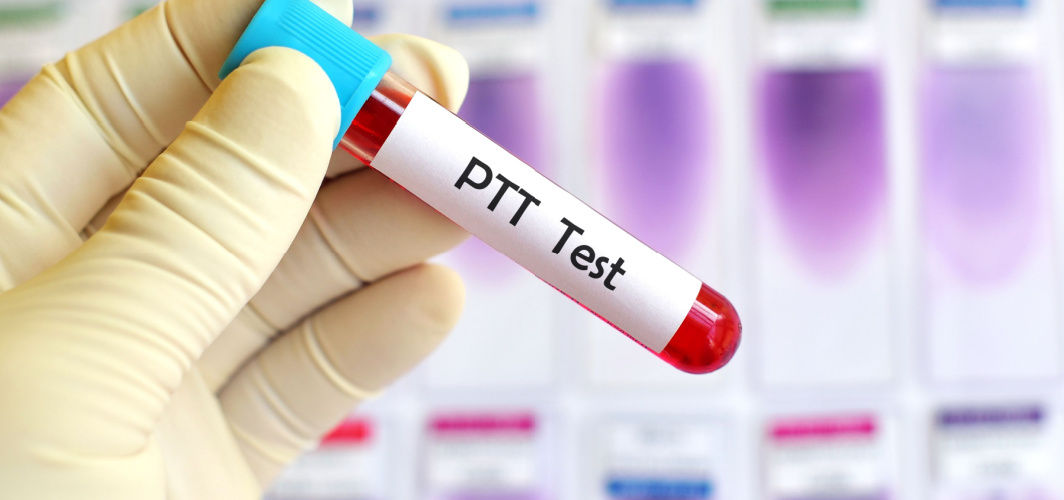General Health
What Is The Purpose Of The PTT Test?
5 min read
By Apollo 24|7, Published on - 09 October 2023
Share this article
0
0 like

The Partial Thromboplastin Time (PTT test), also known as the PTT INR test, is a crucial diagnostic tool used in healthcare. It measures the time it takes for blood to clot and helps determine if there are any abnormalities in the clotting process. Understanding the purpose of the PTT lab test is essential for patients because it provides valuable insights into their blood's clotting ability. By analysing the results, healthcare professionals can identify potential underlying conditions and develop appropriate treatment plans. In this article, we will talk about why the PTT test is taken, as well as the interpretation of its results to help you make better-informed decisions.
What is the PTT test?
The Partial Thromboplastin Time (PTT) test is a blood test that measures the time it takes for blood to clot. It is primarily used to evaluate the function of the clotting factors involved in the intrinsic pathway of coagulation. The PTT test helps assess bleeding disorders, monitor anticoagulant therapy, and detect certain clotting factor deficiencies or abnormalities.
To perform the test, a healthcare professional will draw a blood sample from a vein in your arm. The blood is then mixed with a reagent that initiates the clotting process. The laboratory technician measures the time it takes for the blood to clot using specialised equipment.
When to Take a PTT Test?
Here are some common situations in which a PTT test might be ordered:
1. Hemophilia and other Bleeding Disorders
Hemophilia is a rare genetic disorder characterised by deficient or dysfunctional clotting factors in the blood. There are several types of haemophilia, with Hemophilia A (Factor VIII deficiency) and Hemophilia B (Factor IX deficiency) being the most common.
PTT testing plays a vital role in diagnosing and managing haemophilia. It measures the time it takes for blood to clot and helps determine the severity of the condition. Hemophilia patients often require regular PTT monitoring to adjust treatment plans and prevent bleeding episodes.
2. Monitoring Anticoagulant Therapy
Anticoagulant drugs, such as warfarin and heparin, are prescribed to prevent excessive blood clot formation. They are commonly used in conditions like atrial fibrillation, deep vein thrombosis, and pulmonary embolism. These medications help reduce the risk of stroke and other clot-related complications.
PTT INR testing is of utmost importance in monitoring anticoagulant therapy. It helps healthcare providers assess the effectiveness of the treatment and ensure that blood clotting is appropriately controlled. Regular PTT tests help maintain therapeutic levels of anticoagulants while avoiding the risk of bleeding or clotting complications.
How to Prepare for a PTT Test?
Before undergoing a PTT test, there are a few important factors to consider.
1. Fasting Requirements
Before undergoing a PTT lab test, it is important to check whether fasting is required. In most cases, fasting is not necessary for this test. However, certain healthcare providers may recommend fasting if other tests are being performed alongside the PTT test.
Fasting typically means abstaining from consuming food and beverages, except water, for a specific period before the test. It is crucial to follow the instructions provided by your healthcare provider regarding fasting requirements, if any.
2. Medications to Avoid Before the Test
Inform your healthcare provider about all the medications you are taking before scheduling a PTT test. Some medications can affect the results of the test or the interpretation of the values obtained. Certain drugs such as heparin, warfarin, aspirin, and nonsteroidal anti-inflammatory drugs (NSAIDs) can interfere with blood clotting and impact PTT results. Your doctor may ask you to temporarily discontinue these medications before the test.
3. Other Important Considerations
In addition to fasting requirements and medications, there are other important factors to consider before a PTT lab test. These include informing your doctor about any medical conditions or bleeding disorders you have, as well as any recent surgeries such as heart surgery, joint replacement surgery, or injuries that might affect the test results. It is also essential to follow any specific instructions given by your healthcare provider regarding the PTT test preparation.
How to Interpret PTT Test Results?
When it comes to interpreting the results of a PTT test, there are a few key points to keep in mind regarding the PTT Range. Here's what you need to know:
1. Normal Range
The normal PTT range (Partial Thromboplastin Time) test is typically between 25 to 35 seconds. This test measures the time it takes for blood to clot. When the PTT range falls within this category, it suggests that the blood clotting process is functioning properly. It is important to note that the normal range may vary slightly depending on the laboratory.
2. Abnormal Results
Abnormal PTT range results may indicate an underlying bleeding disorder or a problem with the blood clotting factors. If the PTT is longer than the normal range, it can suggest conditions such as Hemophilia, Von Willebrand disease, or liver disease. On the other hand, if the PTT is shorter than the normal range, it may indicate a higher risk of blood clot formation.
3. Consulting with a Healthcare Provider
If you receive abnormal PTT lab test results, it is crucial to consult with a healthcare provider for further evaluation. They will be able to analyse your results in conjunction with your medical history and other tests to determine the underlying cause of the abnormality. Based on their assessment, they may recommend additional tests or refer you to a specialist for further evaluation and treatment if necessary.
Conclusion
In conclusion, understanding the purpose of the PTT INR test, also known as the partial thromboplastin time test, is crucial for both healthcare professionals and patients. The PTT test is a valuable tool used to assess blood clotting function and measure the time it takes for blood to clot in response to specific chemicals. By working together, healthcare professionals and patients can effectively utilise the PTT test, including assessing normal PTT, to accurately diagnose and manage blood clotting disorders, leading to optimal health outcomes.
General Health
Consult Top Haematologists
View AllFrequently Asked Questions
How long does it take to get the results?
How long does it take to get the results?
Are there any risks or complications associated with the test?
Are there any risks or complications associated with the test?
Can medications or medical conditions affect PTT results?
Can medications or medical conditions affect PTT results?
Can I have a false-positive or false-negative result?
Can I have a false-positive or false-negative result?
Leave Comment
Recommended for you

General Health
From Surya Namaskar To Utrasana: 5 Morning Yoga Asanas To Start Your Day Healthily
Yoga poses help in stretching your body the right way and stimulate various organ systems of your body. You might be surprised by the wonders yoga can do for your body. Read to know more.

General Health
Typhoid Fever: Cause, Symptoms, Diagnosis, Treatment & Prevention
Learn about the common symptoms of typhoid fever, including fever, headache, abdominal pain, and diarrhoea. Stay informed and protect yourself!

General Health
Night Owls Or Early Birds: Who’s More Likely To Develop Heart Ailments & Diabetes?
Researchers conducted a study that compared night owls, those who stay up late, with the early birds, those who are at their most energetic in the mornings. Read to know how these sleeping habits can affect people’s susceptibility to developing certain chronic diseases.
Subscribe
Sign up for our free Health Library Daily Newsletter
Get doctor-approved health tips, news, and more.
Visual Stories

Could There Be More to Your Snore?
Tap to continue exploring
Recommended for you

General Health
From Surya Namaskar To Utrasana: 5 Morning Yoga Asanas To Start Your Day Healthily
Yoga poses help in stretching your body the right way and stimulate various organ systems of your body. You might be surprised by the wonders yoga can do for your body. Read to know more.

General Health
Typhoid Fever: Cause, Symptoms, Diagnosis, Treatment & Prevention
Learn about the common symptoms of typhoid fever, including fever, headache, abdominal pain, and diarrhoea. Stay informed and protect yourself!

General Health
Night Owls Or Early Birds: Who’s More Likely To Develop Heart Ailments & Diabetes?
Researchers conducted a study that compared night owls, those who stay up late, with the early birds, those who are at their most energetic in the mornings. Read to know how these sleeping habits can affect people’s susceptibility to developing certain chronic diseases.

